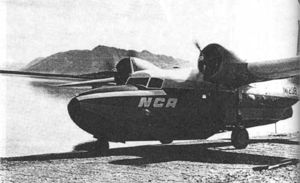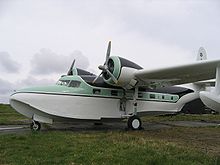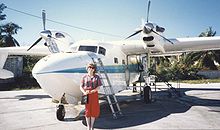Grumman Mallard Video - Landing
|
|
Grumman Mallard
Grumman Mallard

Picture - Grumman G-73 Mallard
Role: Amphibious airliner
Manufacturer: Grumman
First flight: 30 April 1946
Status: In service
Primary user: Chalk's Ocean Airways
Produced: 1946-1951
Number built: 59
Unit cost: $115,000
$4.0 million for turbine powered G-73T
The Grumman G-73 "Mallard" is a large, twin engine amphibious aircraft. Many have been modified by replacing the original Pratt & Whitney Wasp H radial engines with modern turboprop engines. Manufactured from 1946 to 1951, production ended when Grumman's larger SA-16 Albatross was introduced.
Design and development
Building on the success of the Goose and Widgeon, Grumman Aircraft developed Design 73, the larger "Mallard" for commercial use. Retaining many of the features of the smaller aircraft, such as twin radials, high wings with underwing floats, retractable gear and a large straight tail, the company built 59 Mallards between 1946 and 1951. Unlike the smaller aircraft, the Mallard featured tricycle gear, a stressed skin, two step hull and wingtip fuel tanks.
Operational history

Picture -
The Mallard prototype first flew on 30 April 1946, with the first production aircraft entering service in September of that year. While the Mallard was designed for regional airline operations with two pilots and ten passengers especially aimed at harbor-based, city-to-city hops on the eastern seaboard, postwar surplus aircraft sales and the availability of smaller airports limited market potential. A number of smaller air carriers did use the Mallard in its intended role, notably Tahiti-Hawaii Airlines and Pacific Western Airlines (Canada). However, most of the 59 Mallards delivered were for corporate use. A prominent user in Europe in the early 1950s was the Aga Khan.
The Mallard received a lease in life in the 1970s when a number of airframes were refitted by Frakes Aviation with Pratt & Whitney Canada PT6A turbines and upgraded for 17 passengers, to become "Turbo Mallards." Today, through attrition, only 32 Mallards remain registered in the US. Many of the rest are in use around the globe.
A similar program has been undertaken by Paspaley Pearling in combination with Aeronautical Engineers Australia to re-engine and modernise its Mallard fleet, which are used to support its pearling operations in Northern Australia. The fleet has been extensively rebuilt and also reengined with P&WC PT6As and are currently undergoing a life extension program.
Incidents

Picture - Turbo Mallard of Chalk's Airline on a scheduled service at Bimini, Bahamas, in November 1989
The type received much attention after a Turbo Mallard, operating as Chalk's Ocean Airways Flight 101, crashed after take-off from Miami Harbor on 19 December 2005. Eighteen passengers and two crew perished when the right wing separated from the fuselage of the 58-year-old aircraft. The cause of the accident was determined to be cracks and/or corrosion in the wing spar.
Prior to 2005, Chalk's Ocean Airways had an exemplary safety record operating Mallards for many years between Florida and the Bahamas, having never had a passenger fatality since the company began operations in 1917.
Operators
Civil operators
Australia
Paspaley Pearling Co.
Canada
Pacific Western Airlines
United States
Antilles Airboats
Chalk's Ocean Airways
Virgin Islands Seaplane Shuttle
Military operators
Egypt
Royal Egyptian Air Force
Specifications (G-73T)
General characteristics
Crew: two, pilot and co-pilot
Capacity: Up to 17 passengers, but executive configurations are mostly applied.
Length: 48 ft 4 in (14.7 m)
Wingspan: 66 ft 8 in (20.3 m)
Height: 18 ft 9 in (5.72 m)
Empty weight: 8,750 lb (3,970 kg)
Loaded weight: 14,000 lb (6,350 kg)
Useful load: 5,000 lb (2,268 kg)
Max takeoff weight: 14,000 lb (6,350 kg)
Powerplant: 2x— Pratt & Whitney PT6A-34, 600 hp (447 kW) each
Performance
Never exceed speed: 187 kt
Maximum speed: 346km/h (187kt (215 mph))
Cruise speed: 290km/h (157kt (181 mph))
Range: 1,120 nmi (2,070 km (1,288 smi))
Service ceiling: 24,500 ft (7,468 m)
Rate of climb: 1,350 ft/min (6.86 m/s)
Power/mass: .086 hp/lb (max) ()
Related development
HU-16 Albatross
Comparable aircraft
PBY Catalina
Bibliography
Hotson, Fred W. Grumman Mallard: The Enduring Classic. Scarborough, Ontario: Robin Brass Studio, 2006. ISBN 978-1896941448.
Thruelsen, Richard. The Grumman Story. New York: Praeger Publishers, Inc., 1976. ISBN 0-275-54260-2.
Winchester, Jim, ed. "Grumman Goose/Mallard." Biplanes, Triplanes and Seaplanes (The Aviation Factfile). Rochester, Kent, UK: Grange Books plc, 2004. ISBN 1-84013-641-3.
Grumman Mallard Pictures and Grumman Mallard for Sale.
Living Warbirds: The best warbirds DVD series.
Source: WikiPedia